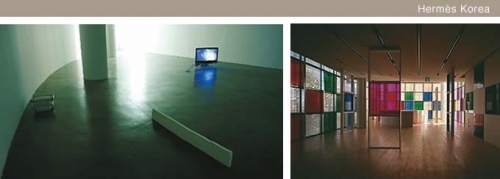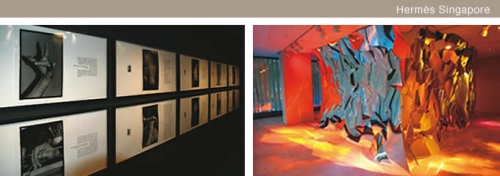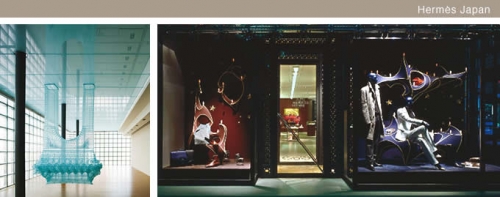‘The maison must be constantly filled with art’
Hermes, a company dedicated to the manufacture of high-quality goods by outstanding craftsmen, has grown to become one of the world’s leading luxury brands. In this issue we explore the company’s art ventures in Japan, the country accounting for around a third of Hermes sales, and in other locations around Asia.
Research/text: ART iT
Hermes, which since its beginnings as a Parisian saddlemaker in 1837 has grown to become an international fashion empire, is also an active patron of the arts. In France for instance in recent years this has included sponsorship of events such as the Indian Summer exhibition of Indian art at the Ecole nationale superieure des Beaux-arts in Paris in 2005. The company has also been busy providing vital support to the arts in countries now home to Maison Hermes flagship stores such as Japan and Korea, and in the wider Asian region.
A ‘shared values’ approach
The Maison Hermes in Ginza, Tokyo for which the architect Renzo Piano was reputedly inspired by a magic lantern is a striking building covered entirely in glass blocks. In accordance with former chairman Jean-Louis Dumas’s insistence that ‘the maison (house) must be constantly filled with art’, since the building opened in 2001 contemporary art shows have been staged around four times annually in the space known as the Forum on the eighth floor. Several superb exhibitions making optimal use of this highly individual venue come to mind, including the Nakagawa Yukio show in which the floor was covered in lavender to resemble a Mediterranean scene, and the show by Suh Do Ho, for which the artist created a gate out of diaphanous blue fabric. Since the store opened, in addition to the shows at the Forum, Hermes Japon General Manager, Communication Fujimoto Kozo has organized a variety of events including screenings at the separate Le Studio cinema, and window displays.
“We’ve spent five years concentrating consistently on contemporary art, so as not to dilute the meaning of the venue,” he says, “and are finding that now, that meaning is finally starting to come through. It’s not a matter of Hermes ‘choosing’ the artists so much as ‘sharing values’. At the same time, we ask the artists to keep in mind the Hermes theme for the year as they work, and share the company’s unique worldview. We operate the art programs in different formats to suit, for example calling in independent curators where necessary, but ultimately our role is to make sure the end result is a high quality exhibit.”
As the basic precepts set out by former chairman Dumas, such as finding art in the everyday, not presuming to be part of the arts simply by providing financial assistance to the arts, and not using art for promotional purposes suggest, the Hermes position has consistently been to stick to what the company does well: producing quality goods, and leave art to the art world experts.
Global multilocalism
‘Global multilocalism’ is a key phrase in the Hermes lexicon. Based on a belief that local matters are best left to local people, the branches of the company established in countries around the world each have their own mode of operation. The same goes for the company’s involvement in the arts.
The Hermes Korea Missulsang art prize for Contemporary Korean Art established by Hermes Korea in 2000 is attracting more attention from within Korea and overseas every year. Previous winners read like a roll-call of some of the country’s top artists, including Bahc Yiso (2002), Suh Do Ho (2003), and Koo Jeong-A (2005). Since 2003 the judging process has been open to the public, and has earned an excellent reputation for fairness. Judging begins at the start of the year, when five nominating committees recommend two artists each. From these ten artists, three finalists are chosen by a judging committee of three Korean and two foreign panelists. These three artists produce new works with financial support from Hermes, and the judging committee determines the final winner. The prize money is 20 million won (approx. 2.5 million yen). For the seventh prize in 2006, the three artists nominated are Kim Sang-gil, Bae Young Whan, and Lim Minouk, with the winner to be announced in March 2007.
The Maison Hermes Dosan Park complex that opened in November 2006 incorporates the Atelier Hermes contemporary art space. The plan is to use the Atelier, which was launched with a show by Daniel Buren, as a venue for four or five exhibitions a year.
Meanwhile, Hermes Singapore, which launched its Third Floor Hermes gallery last year, exhibited work by Kuribayashi Takashi in its capacity as a venue for the Singapore Biennale. The Kuribayashi exhibit was linked to an exhibit at another venue, the Tanglin Camp former military barracks, forming an unconventional art space. The Hermes Singapore policy of readily accepting work from both local and overseas artists – reflective perhaps of Singapore’s multiethnic society – makes for some fascinating shows.
“We aim to be objective in all we do,” he says, “and not be swayed by the latest trend.” Only a company obsessed with quality and in which tradition and innovation sit side by side could engage in such multifaceted cultural activities. And one suspects this is only the beginning.

Left: Koo Jeong-A’s Hermes Korea Missulsang art prize-winning work, Ssisai, 2005
Right: installation view of Daniel Buren’s Atelier Hermes opening exhibition, Filtres Colores

Left: installation view of Anne de Vandiere’s H/AND exhibition, 2006
Right: installation view of Yann Kersale’s RE-FLEXION-S exhibition, 2006

Left: installation view of Suh Do Ho’s Forum exhibition, Reflection, 2005
Photo Nacasa & Partners Inc., courtesy Hermes Japon
Right: Nakamura Tetsuya, window display, 2006
Photo Asakawa Satoshi, courtesy Hermes Japon
Hermes Japon
5-4-1, Ginza, Chuo-ku, Tokyo
+81(0)3-3569-3300
Hermes Korea
Maison Hermes Dosan Park, 630-26, Sinsa-dong, Gangnam-gu, Seoul 135-895
+82(0)2-3015-3212
Hermes Singapore
541 Orchard Road, Liat Towers
+65-6738-9807
Originally printed in ART iT 14 Winter/Spring 2007
